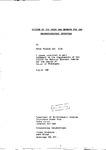STUDIES OF TIN OXIDE GAS SENSORS FOR GAS CHROMATOGRAPHIC DETECTION
| dc.contributor.author | Ash, Peter William | |
| dc.contributor.other | School of Geography, Earth and Environmental Sciences | en_US |
| dc.date.accessioned | 2013-10-07T11:50:54Z | |
| dc.date.available | 2013-10-07T11:50:54Z | |
| dc.date.issued | 1990 | |
| dc.identifier | NOT AVAILABLE | en_US |
| dc.identifier.uri | http://hdl.handle.net/10026.1/2066 | |
| dc.description.abstract |
Gas sensitive semiconductors have been known for many years and applied in static gas alarm systems for the monitoring of hazardous gases, however, their application has been limited by a lack of selectivity. In this work a semiconducting gas sensor has been configured for use as a gas chromatographic detector thus combining the sensitivity of semiconductor sensors with the selectivity of gas chromatography. The study has been confined to tin oxide devices, more specifically the Taguchi gas sensor (TGS) . The majority of this work has concentrated on the TGS 813 although the use of other TGS is described. The development of suitable instrumentation is described and rigorous optimisation of the operating parameters e.g. heater voltage and column temperature has been performed using the variable step size simplex technique. Attention was concentrated on the response of the TGS 813 to hydrogen which was used as a test gas. A novel figure of merit, response multiplied by retention time and divided by skew factor was designed so that optimum response was obtained whilst maintaining adequate chromatographic separation. Optimum conditions were verified by univariate searches and the response was observed to be most dependant upon heater voltage. A limit of detection of 20 ppb v/v of hydrogen in a 1 ml sample was obtained at optimal conditions. Illustrative analyses of hydrogen were performed in human breath and laboratory air with results found to be in close agreement with literature values. Calibration was found to be linear over at least three orders of magnitude. The response of the TGS 813 to low molecular weight alkanes has also been investigated. It was observed that different heater voltage optima existed for each of the C1-C5 alkanes and that the sensor was relatively more sensitive to the higher molecular weight compounds. As with hydrogen linear response was obtained over at least three orders of magnitude and an illustrative analysis of natural gas showed excellent agreement with known levels. A compromise optimum heater voltage was used to study the response of the TGS 813 to alcohols, aldehydes, ketones and some Cs hydrocarbons. Capillary columns were used in this investigation and it was noted that they had potentially wider application than packed columns due to the use of an inert carrier with an air make-up flow to the detector. This replaced the air carrier gas used previously which might degrade certain stationary phases. Three different types of TGS: the 813; 822 and 831 were used in a study of the response and skew factor for the detection of halogen-containing compounds. Very high skew factors were often observed, although, for some compounds it appeared that symmetrical peaks could be obtained within narrow heater voltage ranges. Skewed response was observed to be dependant upon sensor type, heater voltage and halogen proportion and type. Analysis of the three sensor types was performed and differences in potential surface area and tin oxide additives observed. The presence of additives was observed to adversely affect sensor recovery. | en_US |
| dc.description.sponsorship | Philips Scientific, York Street, Cambridge CBl 2PX | en_US |
| dc.language.iso | en | en_US |
| dc.publisher | University of Plymouth | en_US |
| dc.title | STUDIES OF TIN OXIDE GAS SENSORS FOR GAS CHROMATOGRAPHIC DETECTION | en_US |
| dc.type | Thesis | |
| plymouth.version | Full version | en_US |
| dc.identifier.doi | http://dx.doi.org/10.24382/4706 | |
| dc.identifier.doi | http://dx.doi.org/10.24382/4706 |
Files in this item
This item appears in the following Collection(s)
-
01 Research Theses Main Collection
Research Theses Main


